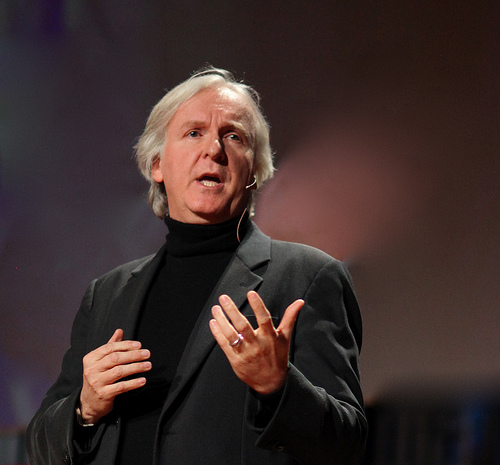![]() Photo: Official Avatar Movie photostream via FlickrHe’s made the highest grossing film on the planet, but Hollywood mega-director James Cameron is now promoting “Avatar” as the most successful environmental film of all time, too. Really.
Photo: Official Avatar Movie photostream via FlickrHe’s made the highest grossing film on the planet, but Hollywood mega-director James Cameron is now promoting “Avatar” as the most successful environmental film of all time, too. Really.
“There is no studio anywhere in the world who would say an environmental message would make $3 billion … I can’t think of any other really commercially successful ones, can you?” he said during an interview at a Santa Monica fundraiser last Monday for the environmental group Natural Resources Defense Council.
“‘WALL-E’, maybe?” replied his wife, actress Suzy Amis Cameron.
It was Amis Cameron who asked an astonished, grateful NRDC if they would like her husband to appear at a quickly arranged fundraiser starring Cameron and his sci-fi blockbuster, which features a mother tree deity. The film is nominated in nine Oscar categories, after all, including best director and best picture. Hooking up with NRDC was, if you think about, perfectly natural.
Talking to a graduate film student at the event, Cameron warmed to his message that he’s the greatest enviro director, comparing his work to “An Inconvenient Truth,” which he called boring with bar charts. “If it wasn’t Al Gore, nobody would have listened,” he said, but then ruefully admitted he made four semi-successful documentaries about the ocean before plunging into “Avatar.”
“I wanted to do a film that had a deeply embedded environmental message … but do it in the form of a science fiction action adventure,” Cameron told local public radio host Elvis Mitchell. “My feeling was if we have to go four light years away to another planet to appreciate what we have here on earth, that’s okay.”
He wanted, he said, to pack such an emotional wallop that by the time the film’s giant, sheltering tree is felled, everyone in the theater would feel moral outrage. Further, after the triumph of nature’s creatures over evil military contractors, he wanted the audience to feel hopeful enough to do something.
“Avatar” may be the most explicitly environmental film of Cameron’s oeuvre, but he insists he’s been making them all his life, from a high school work entitled “The Extinction Syndrome” to his obsession with nuclear war fears à la the “Terminator” series.
Cameron’s environmental zeal started early. Though he spent his childhood in a Canadian farm town, he earned his scuba certification in a landlocked swimming pool. When he was 17, his family moved to inland southern California, but he homed in on the beach, surfing off Huntington and Laguna, then switching to scuba diving.
In recent years he has done group submersible dives, exploring and noting the slow degradation of coral reefs. Oceanic influences infuse “Avatar’s” phosphorescent lighting and dreamlike landscapes. The giant, whirly creatures that shrivel up when Sully taps them were based on sea worms. He had a team of the planet’s best designers, Cameron said, but every time they invented something spectacular, they found Mother Nature had done something better.
Cameron seems pretty well positioned to take on right-wing climate deniers, having made “The Terminator” for Fox when Rush Limbaugh was a California cow town radio host. At the NRDC event, he refused to debate about Fox News commentators, however, noting he works for a different division, though he confirmed studio executives asked him to “tone down the tree-hugger crap.” He refused, but art imitated studio life when Jake Sully, the contract soldier who is the main character, says he hopes “all the tree-hugger crap” he’s being exposed to “won’t be on the final.”
Tree hugging is not, Cameron acknowledged, in the moviemaking industry’s genetic makeup, it being a carbon-intensive process. But, he insists, his family’s use of hybrid vehicles, fluorescent bulbs, and other sustainable products is his way of making a difference. Okay sure, that should even things out.
It might have been an NRDC event, but the mobs were vintage Hollywood, even if there were high schoolers and Amazon River activists mixed in with the “Aliens” fans and wannabe filmmakers. One man’s daughter had attended a birthday party for one of Cameron’s’ kids and said he’d have his child slip a copy of his documentary on soil to Cameron’s child to pass on to him. Have your girl call my girl. We’ll do lunch.
I joined the mob, testing Cameron’s green chops: Wind power (he’s a huge fan), clean coal (it doesn’t exist), the failure of Obama and other world leaders at Copenhagen (agreed), cap-and-trade, he was acquainted with them all, even a bit directa-torial in his opinions. But he gave as good as he got. When I noted that acid rain was still spreading despite cap-and-trade, he retorted that it’s not spreading as fast as it would have. He asked what a better solution might be. Tough new regulations?
Fine, “I’m willing to engage or indulge real ideas,” he said. “But if we don’t do something, we’re all going to die! What’s it going to take, a big fucking disaster with all kinds of people dying? We need to change our priorities fast.”
Cameron said he has been overwhelmed with requests from environmental groups, and will probably do more events, since his wife told him, “Maybe more than an opportunity, maybe there’s a duty to try to use this film for whatever good can be brought to bear.”
He added, “The environmental message maybe got lost earlier in all the talk about 3-D … It’s time to start having that conversation more.”




